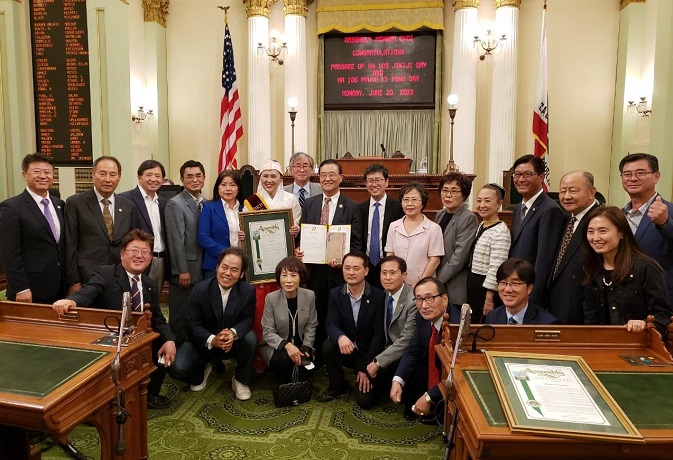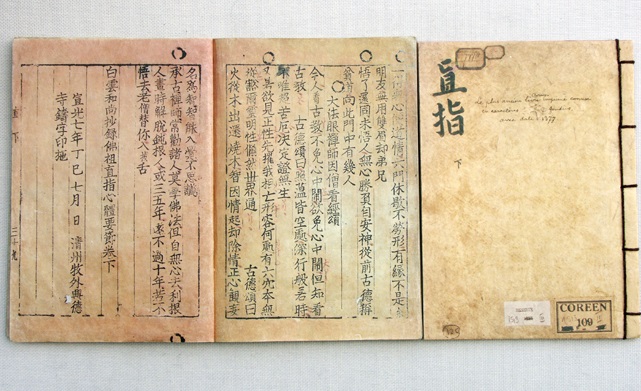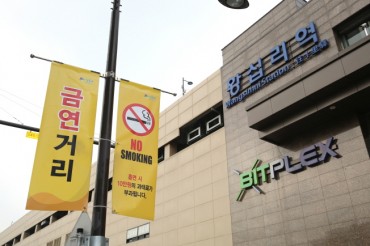CHEONGJU, June 23 (Korea Bizwire) — California’s legislature has introduced “Jikji Day,” which proclaims that “Jikji,” the world’s oldest existing metal-printed book.
Under the resolution introduced by by Californian Assemblyman Steven Seokho Choi, which was passed on Monday (local time), the U.S. state of California plans to celebrate September 4 as “Jikji Day,” according to the Cheongju Early Printing Museum.
California is the first entity in the U.S. to pass a resolution for the new Jikji Day.
Jikji was printed in 1377 at the Heungdeok Temple in the central city of Cheongju during the Goryeo Dynasty (918-1392). That was 78 years prior to the printing of Gutenberg’s 42-line Bible in Europe.
UNESCO confirmed Jikji as the world’s oldest metal-printed book in 2001 and included it in the UNESCO Memory of the World registry that year.
Image Credit: Cheongju City Government / Cheongju Early Printing Museum / photonews@koreabizwire.com









Congratulations on California’s creation of “Jikji Day.” That is a phenominal idea !
I would like to bring to your attention a collaborative project supported by the National Endowment for the Humanities and the the Overseas Korean Cultural Heritage Foundation called, From Jikji to Gutenberg. Below, please find a news release about the project.
April 13, 2022 – The J. Willard Marriott Library at the University of Utah is pleased to announce a $74,999 Exhibitions Planning award from the National Endowment for the Humanities (NEH) in support of the initiative, From Jikji to Gutenberg: The Origins of Printing from Cast-Metal Type. The NEH grant complements the Overseas Korean Cultural Heritage Foundation bequest of $68,150 awarded to the project in January 2022.
While it is generally recognized that Johannes Gutenberg printed the monumental 42-line Gutenberg Bible in Mainz, Germany about 1455, it remains largely unknown outside of East Asia that Jikji, the world’s oldest surviving book printed from moveable metal type, was printed 78-years earlier in Cheongju, South Korea. The goal of the From Jikji to Gutenberg project is to magnify and underscore the invention of printing as a global phenomenon rather than a Eurocentric achievement.
Early Korean printing remains a cultural blind spot in the West partly because the sole surviving copy of Jikji is generally inaccessible. France’s acquisition of this cultural icon includes questions of colonial illegitimacy, and South Korea has asked for its return. Now deemed Korean National Treasure No. 1132, the Buddhist text was relocated to France in the late 19th century, and then sold at auction by the first French consul to Korea, Victor Collin de Plancy. The buyer, a prosperous jeweler and collector named Henri Vever, specified his desire for the book be donated to the Bibliothèque nationale de France (BnF) and in 1950, seven years after his death, his family complied with this wish. Jikji remained unrecognized for 20 years until Korean historian Park Byeongseon took a job at the BnF and located the book along with other Korean treasures. The BnF chose to display the book in 1972, and again in 1973, but it has not been seen in public since. For nearly 50 years the memory of Jikji and its international significance has been marginalized, and in so doing the knowledge of Korea’s achievement has been suppressed.
The From Jikji to Gutenberg initiative consists of an interdisciplinary team of over 40 people – historians, material specialists, conservators and scientists working in 14 time zones and committed to conducting original research (2022), publishing a scholarly, 400-page exhibit catalog (2025), and coordinating an international exhibit to commemorate the 650th anniversary of Jikji’s printing in 2027. Through a competitive application process in 2021 the project was awarded “beam time” at Stanford University’s Synchrotron Radiation Lightsource (SSRL) to conduct XRF elemental analysis and multispectral imaging for the purpose of characterizing the chemical footprint of printing inks from the Gutenberg 42-line Bible (c. 1455) and examples of early Korean printing predating Gutenberg. Testing will also include micro-sampling of pigment for identification of the binder by the Conservation and Scientific Research department of the Smithsonian Institution’s National Museum of Asian Art.
A “Bridge Program” is bringing project partner Dr. Lee, Seung-cheol (Director, Research & Development Division, UNESCO International Centre for Documentary Heritage, Korea) to the U.S. twice in 2022 to confer on issues pertaining to early Korean printing. In May, Dr. Lee will meet with collaborators at the Library of Congress, Smithsonian Institution’s National Museum of Asian Art, and Princeton University, and later this summer he will return with early examples of Korean printing to actively participate in the XRF scanning at SSRL.
In April 2023, From Jikji to Gutenberg will hold a scholarly symposium at the Library of Congress to familiarize the team’s participants with the results of the scientific investigation and to encourage debate of shared drafts of everyone’s paper for the exhibit catalog to be published in 2025. The catalog will be available at each venue of the 2027 exhibit to offer insights into East Asian and Western European 14th and 15th century metal type casting, ink manufacture, handmade paper production, bookbinding, and the printing process itself – as well as patterns of book distribution, literacy, and the cultural impact of printing in opposite sides of the globe.
In 2027, a two-month, multilingual exhibit will open simultaneously in nine U.S. and 34 international research libraries located in 14 countries. The Library of Congress and Princeton University Library, the first two institutions invited, have committed to participate and will serve as models as other libraries are invited in 2023. With UNESCO’s support, an international conference will also be convened in Cheongju, Republic of Korea, to further disseminate the team’s findings and engage scholars and the general public worldwide.
Positive outcomes sought in the project’s multiple phases include the first recreation by typographic historians of Gutenberg’s exact type casting system; a paper historian (and MacArthur Fellow) comparing unique aspects of early Asian and European sheet formation; elemental mapping to verify methods of manufacturw; exploration of the spread of moveable type printing across Eastern Asia and Western Europe; and dissemination of little-understood patterns of contemporaneous Korean printed editions, such as Jikji printed from type (c. 1377) and Jikji printed from woodblocks (c. 1378).
Coordinated by Head of Preservation Randy Silverman, the scholarly project will roll out in phases over the next five years, culminating in a greater understanding of East Asia’s technological contributions to world culture. Please see the nine-minute video about the project made in collaboration with the Korean Cultural Center, Los Angeles, on the From Jikji to Gutenberg.